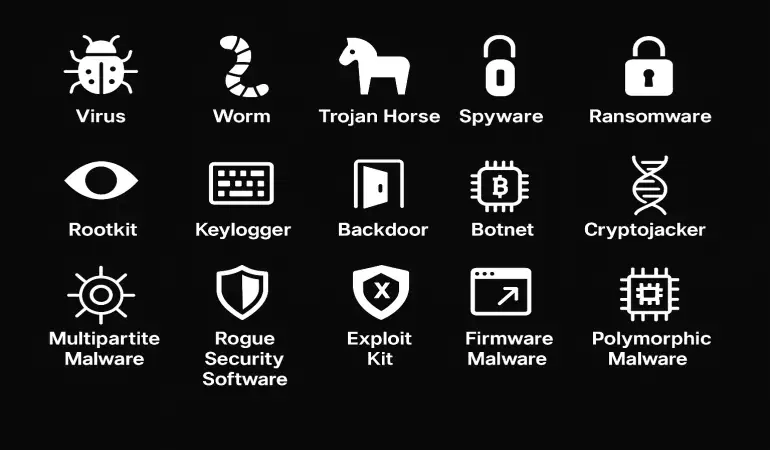The Most Important Types of Malware: Function, Goal, and Famous Examples
In today's increasingly connected world, understanding the different types of malware is more important than ever. Each type of malware has its own purpose, uses specific techniques, and can cause severe damage. Here’s a compact yet comprehensive overview of the most well-known malware types – their function, their goal, and a famous example for each:
April 28, 2025 15:52
Virus
Function:
A virus is a self-replicating program that attaches itself to clean files or software and spreads when those files are opened. It can corrupt, delete, or render systems inoperable.
Goal: To infect as many systems as possible and cause destruction.
Example: ILOVEYOU (2000) spread rapidly via email attachments, causing billions in damages worldwide.
Worm
Function:
Unlike viruses, worms spread automatically without user interaction, exploiting vulnerabilities in networks or software.
Goal: Rapid, autonomous spread and network disruption.
Example: Blaster Worm (2003) infected hundreds of thousands of Windows computers.
Trojan Horse
Function:
Trojans disguise themselves as legitimate software to trick users into installing them. Once active, they can spy on users, steal data, or open backdoors.
Goal: Deception to gain unauthorized system access.
Example: Emotet initially emerged as a banking Trojan before evolving into a major malware platform.
Spyware
Function:
Spyware secretly monitors user behavior, recording activities like keystrokes, browsing habits, and location data.
Goal: Stealing sensitive personal or financial information.
Example: Pegasus was used to spy on politicians and activists globally.
Adware
Function:
Adware bombards users with unwanted advertisements and often tracks their online behavior.
Goal: Generate revenue through ads and user tracking.
Example: Fireball infected millions of computers and hijacked web traffic.
Ransomware
Function:
Ransomware encrypts user data or locks systems and demands payment to restore access.
Goal: Financial extortion from individuals, businesses, and governments.
Example: WannaCry (2017) crippled systems worldwide, especially in healthcare.
Scareware
Function:
Scareware tricks users into believing their system is infected, pressuring them into buying fake or harmful software.
Goal: Financial gain through psychological manipulation.
Example: SpySheriff created false virus warnings to scam users into paying.
Rootkit
Function:
Rootkits modify core system functions to hide malware from detection and ensure long-term presence.
Goal: Stealthy control over compromised systems.
Example: Sony BMG Rootkit (2005) was secretly installed via certain music CDs.
Keylogger
Function:
Keyloggers record every keystroke typed by a user, capturing passwords, credit card numbers, and private messages.
Goal: Silent data theft for identity or financial crimes.
Example: Olympic Vision targeted corporate networks for sensitive data.
Backdoor
Function:
Backdoors create hidden access points into systems, allowing attackers to bypass normal authentication.
Goal: Stealthy unauthorized remote control of devices.
Example: Back Orifice gave hackers full control over infected Windows systems.
Botnet
Function:
A botnet is a network of infected devices controlled remotely to perform coordinated tasks, such as spam campaigns or DDoS attacks.
Goal: Mass manipulation or attacks using many compromised systems.
Example: Mirai Botnet (2016) disrupted major internet services worldwide.
Cryptojacker
Function:
Cryptojacking malware secretly uses victims' computing resources to mine cryptocurrency.
Goal: Financial profit without user consent.
Example: Coinhive scripts were embedded in websites for unauthorized mining.
Fileless Malware
Function:
Fileless malware operates in a computer's memory (RAM) without leaving traditional file traces, making it hard to detect.
Goal: Avoid traditional antivirus detection.
Example: PowerGhost infected global corporations using fileless attack methods.
Polymorphic Malware
Function:
Polymorphic malware constantly changes its code while keeping its original function, evading signature-based detection.
Goal: Outwit antivirus software.
Example: Storm Worm (2007) used polymorphic techniques to spread undetected.
Multipartite Malware
Function:
Multipartite malware infects multiple parts of a system (e.g., boot sector and files) simultaneously.
Goal: Maximize infection success and resilience.
Example: Tequila Virus was an early example of multipartite infection strategies.
Rogue Security Software
Function:
This malware pretends to be legitimate antivirus software and tricks users into paying for fake security solutions.
Goal: Financial fraud by exploiting fear.
Example: Antivirus 2009 was a widespread fake antivirus scam.
Exploit Kit
Function:
An exploit kit is a toolkit designed to automatically scan for and exploit software vulnerabilities, usually via malicious websites.
Goal: Mass deployment of malware through known security flaws.
Example: Angler Exploit Kit was one of the most powerful before disappearing in 2016.
Firmware Malware
Function:
Firmware malware infects the low-level software (BIOS, UEFI, etc.) that boots up devices, persisting even after reformatting or reinstalling the OS.
Goal: Achieve deep, persistent, and hard-to-remove system control.
Example: LoJax was the first malware to successfully target UEFI firmware.
Mobile Malware
Function:
Mobile malware targets smartphones and tablets to steal data, track users, or take control remotely.
Goal: Exploit mobile ecosystems for financial or espionage purposes.
Example: HummingBad infected over 10 million Android devices.
Banking Trojan
Function:
Banking Trojans monitor online banking activities to steal login credentials and manipulate financial transactions.
Goal: Direct theft from victims' bank accounts.
Example: Zeus Trojan became infamous for its role in widespread online banking fraud.
Screenlogger
Function:
Screenloggers capture screenshots instead of (or in addition to) keystrokes to gather sensitive visual information.
Goal: Steal information visible on the user's screen.
Example: QRecorder combined screenlogging and keylogging for full surveillance.
RAT (Remote Access Trojan)
Function:
RATs allow attackers to remotely control infected systems, including access to files, webcams, microphones, and more.
Goal: Complete takeover for spying, theft, or sabotage.
Example: DarkComet was widely used for cyber espionage.
Bootkit
Function:
Bootkits infect the boot process, allowing malware to load before the operating system, making it very hard to detect or remove.
Goal: Persistent, early-stage control of the system.
Example: TDL4 Bootkit was notorious for hiding deep inside Windows systems.
Final Thoughts
Malware comes in many forms, each with its own unique way of attacking systems and users.
Understanding these types helps individuals and organizations recognize threats early and take preventive measures before it's too late.
Stay informed – and stay protected!
